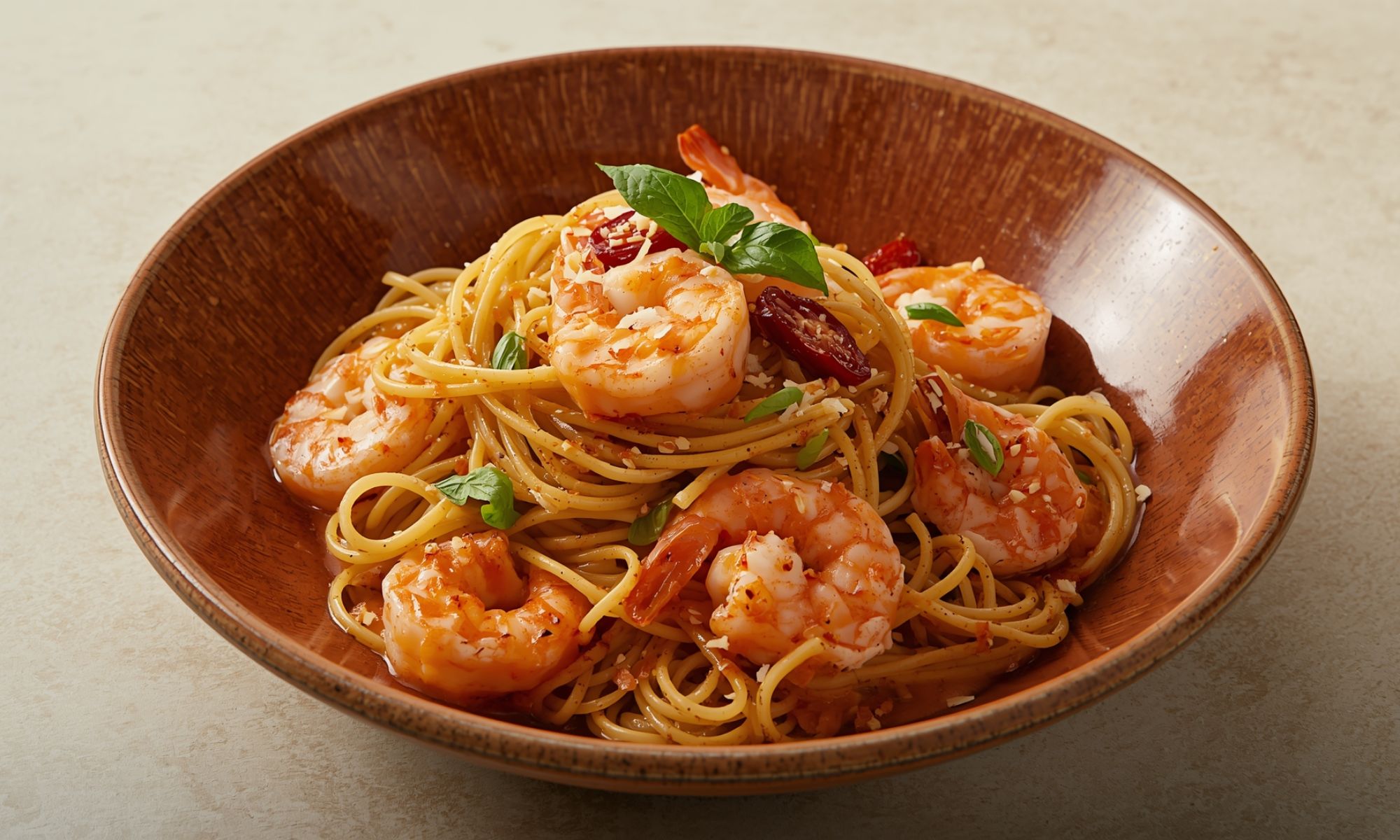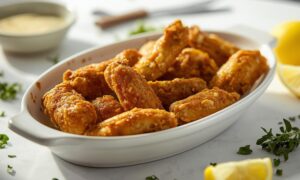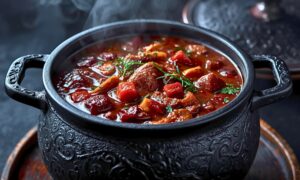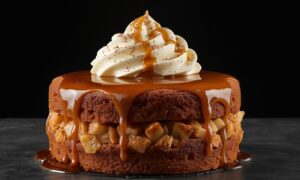Picture this: steam rising from creamy, golden pasta. Plump shrimp glistening like little jewels. The aroma hitting you like a warm hug. That’s exactly what happened when my neighbor Sarah made her famous Marry Me Shrimp Pasta for her boyfriend last spring. Three months later? Diamond ring on her finger.
Now, I’m not saying this dish has magical powers. But I’ve watched it work miracles in kitchens across my neighborhood. There’s something about the way garlic sizzles in butter. How cream swirls into silky perfection. The moment when everything comes together and you know you’ve created something special.
This isn’t just dinner. It’s an experience. A conversation starter. A memory maker.
The secret lies in the balance. Rich but not heavy. Elegant but approachable. Complex flavors that somehow feel like home. Every single bite delivers comfort with a touch of sophistication. It’s restaurant quality food made in your own kitchen.
And here’s the beautiful part. You don’t need years of culinary school. No fancy equipment required. Just good ingredients, proper technique, and a little love. I’m gonna walk you through every step. Share the tricks that make the difference. Give you the confidence to create something truly memorable.
Because life’s too short for boring pasta. Let’s make something that matters.
The Magic Behind This Recipe

Real talk: most shrimp pasta falls flat. Either the shrimp turns rubbery. The sauce breaks into a greasy mess. Or it tastes like cafeteria food with delusions of grandeur.
This recipe fixes all those problems. We’re cooking the shrimp just right. Building flavors layer by layer. Creating a sauce that clings to every strand of pasta. The result? Pure harmony on a plate.
What makes this version special starts with technique. We sear the shrimp first. Lock in that sweet, briny flavor. Then use that same pan for the sauce. All those caramelized bits become part of our flavor foundation.
The cream sauce isn’t just cream and hope. We’re building complexity with garlic, white wine, and fresh herbs. Each ingredient plays a specific role. Nothing’s there just for show.
And the pasta? We’re cooking it just shy of perfect. Letting it finish in the sauce. This creates that restaurant quality coating that makes every bite sing.
Core Ingredients That Make the Difference
For the Shrimp:
- 1.5 pounds large shrimp, peeled and deveined
- 2 tablespoons olive oil
- 3 cloves garlic, minced
- 1 teaspoon paprika
- Salt and black pepper to taste
For the Pasta & Sauce:
- 12 oz fettuccine or linguine
- 4 tablespoons butter
- 4 cloves garlic, minced
- 1/2 cup white wine (or chicken broth)
- 1 cup heavy cream
- 1/2 cup freshly grated Parmesan
- 1/4 cup fresh basil, chopped
- 2 tablespoons fresh parsley
- Red pepper flakes (optional)
- Salt and pepper to taste
Smart Swaps When Life Happens:
Can’t find large shrimp? Medium works fine. Just watch the cooking time. They’ll cook faster than you think.
No white wine? Chicken broth adds depth without alcohol. Or skip it entirely and add extra cream.
Heavy cream making you nervous? Half and half works. Your sauce won’t be as rich, but it’ll still taste amazing.
Parmesan breaking the budget? Pecorino Romano brings similar sharpness. Even good quality pre grated will do in a pinch.
Fresh herbs unavailable? Dried basil and parsley work. Use about half the amount. Add them earlier in the cooking process.
Picking Perfect Ingredients
Shrimp shopping can feel overwhelming. Here’s what actually matters: look for firm texture and minimal smell. Fresh shrimp shouldn’t smell “fishy” at all. More like ocean breeze.
Size matters for cooking time. But don’t stress too much. Large or jumbo work beautifully here. Just adjust your timing accordingly.
For pasta, go with something that holds sauce well. Fettuccine is classic. Linguine works great too. Even penne will make you happy.
Garlic should feel firm when squeezed. No soft spots or green shoots. Those add bitterness you don’t want.
Parmesan deserves special attention. Pre grated is convenient but lacks punch. Fresh grated makes a noticeable difference. If you’re gonna splurge anywhere, make it here.
Step by Step Kitchen Magic

Getting Your Shrimp Ready
Pat those shrimp completely dry. This isn’t optional. Wet shrimp won’t sear properly. They’ll steam instead. You want that golden caramelization.
Season them generously with salt, pepper, and paprika. The paprika isn’t just for color. It adds subtle smokiness that elevates everything.
Heat your largest skillet over medium high heat. Add olive oil when the pan’s hot. You’ll know it’s ready when the oil shimmers.
Cook shrimp in a single layer. Don’t crowd them. Work in batches if needed. Each shrimp gets about 2 minutes per side. They’ll turn pink and slightly golden. Perfect.
Remove to a plate. Don’t clean that pan. All those beautiful browned bits? That’s flavor gold.
Building the Foundation
Same pan, lower heat to medium. Add butter and let it melt completely. When it stops foaming, add minced garlic.
This part requires attention. Garlic can go from fragrant to bitter in seconds. Stir constantly. About 30 seconds of gentle cooking does it.
Pour in white wine. Listen for that satisfying sizzle. Scrape up any browned bits from the shrimp. This is where magic happens.
Let the wine reduce by half. Takes about 2-3 minutes. You’ll smell when it’s ready. Sharp alcohol scent becomes mellow and sweet.
Creating Creamy Perfection
Pour in heavy cream slowly. Whisk gently as you add it. This prevents any separation issues.
Bring to a gentle simmer. Not a rolling boil. That can break your sauce. Just tiny bubbles around the edges.
Add half your Parmesan now. Whisk until smooth. The cheese thickens everything beautifully. Creates that glossy finish you’re after.
Season with salt and pepper. Taste as you go. Remember, the pasta water and cheese both add saltiness.
Bringing It All Together
Your pasta should be cooking during sauce prep. Start it when you begin the garlic. Timing matters here.
Cook pasta 1-2 minutes less than package directions. It’ll finish in the sauce. This technique prevents mushy results.
Reserve 1/2 cup pasta water before draining. That starchy liquid is liquid gold for adjusting consistency.
Add drained pasta directly to your sauce. Toss everything together. Add pasta water gradually if things look too thick.
Return shrimp to the pan. Fold in gently. Just enough to warm them through. About 1 minute does it.
Remove from heat. Add fresh herbs, remaining Parmesan, and a final seasoning check.
Pro Tips That Make the Difference
Temperature control wins this game. High heat for shrimp searing. Medium for garlic. Gentle simmer for cream sauce.
Don’t rinse your pasta. Those surface starches help everything stick together.
Taste constantly during sauce building. Your palate is the best guide. Trust what you taste.
If sauce breaks or looks grainy, whisk in pasta water off the heat. Usually brings it back together.
Timing is everything. Have ingredients prepped before you start cooking. This dish moves quickly once you begin.
The Science Behind Perfect Marry Me Shrimp Pasta
Understanding why techniques work makes you a better cook. Let’s dig into the magic happening in your pan.
When we sear shrimp at high heat, we’re creating the Maillard reaction. That’s the chemical process that creates complex flavors and appealing colors. It’s why seared food tastes better than steamed.
The garlic blooming in butter releases compounds that are fat soluble. They wouldn’t develop the same way in water or wine alone. This step builds your flavor foundation.
Wine reduction concentrates flavors while cooking off harsh alcohol. What remains is pure essence. Sweet and complex without overwhelming the dish.
Cream sauce science gets interesting. Heavy cream has enough fat to remain stable at gentle cooking temperatures. Lower fat options might curdle or separate.
Adding cheese off heat prevents proteins from seizing up. Hot enough to melt, not so hot it becomes stringy.
Finishing pasta in sauce creates an emulsion. Starchy pasta water helps everything bind together. This is why restaurant pasta always seems to coat better.
Essential Equipment for Success
A large, heavy bottomed skillet is your best friend here. Cast iron or stainless steel both work beautifully. Non stick can work but won’t give you those flavorful browned bits.
A pasta pot with plenty of room prevents sticking. Cramped pasta cooks unevenly.
Sharp knives make prep work pleasant. Dull blades are dangerous and frustrating.
A microplane grater transforms hard cheese into fluffy clouds. Worth every penny if you cook regularly.
Wooden spoons won’t scratch your pan or conduct heat to your hand. Perfect for stirring hot sauces.
Making It Restaurant Beautiful
Presentation transforms good food into an experience. Here’s how to make your Marry Me Shrimp Pasta look as amazing as it tastes.
Warm your serving bowls. Hot food on cold plates loses temperature quickly. Just run them under hot water and dry thoroughly.
Twirl pasta into neat nests using a large spoon and fork. Place in the center of each bowl. Creates height and visual appeal.
Arrange shrimp artfully around the pasta. Not scattered randomly. Think of creating visual balance.
Garnish matters here. Fresh herbs add color and freshness. A light dusting of Parmesan looks elegant.
A drizzle of good olive oil adds glossy finish. Just a little around the plate’s edge creates professional appearance.
Perfect Pairings That Complete the Meal
Wine pairing with creamy shrimp pasta offers delicious options. Crisp white wines cut through richness beautifully. Sauvignon Blanc or Pinot Grigio work perfectly.
Prefer red? Light bodied options like Pinot Noir won’t overwhelm delicate shrimp flavors.
For sides, keep things simple. A crisp Caesar salad provides textural contrast. Garlic bread feels indulgent but might be overkill.
Steamed asparagus or roasted broccoli add freshness. The vegetables’ slight bitterness balances the rich sauce perfectly.
For special occasions, start with a light appetizer. Bruschetta or a simple antipasto plate sets the Italian American mood.
Mastering Variations and Personal Touches

Once you’ve nailed the basic technique, creativity takes over. This recipe welcomes experimentation.
Vegetable Additions: Sun dried tomatoes add tangy sweetness. Chop roughly and add with the garlic.
Spinach wilts beautifully into hot pasta. Add it at the very end. Just until it turns bright green.
Mushrooms bring earthy depth. Sauté them separately first. Fold in just before serving.
Bell peppers add color and crunch. Red or yellow work best. Green can taste too sharp.
Protein Variations: Chicken works beautifully here. Cut into bite sized pieces. Cook exactly like the shrimp.
Scallops create an elegant twist. They need the same high heat searing technique.
Crab meat makes this ultra luxurious. Use lump crab. Add it gently at the end to avoid breaking up those beautiful pieces.
Spice Level Adjustments: Red pepper flakes add gentle heat. Start with a pinch. You can always add more.
Fresh jalapeños bring more complex heat. Remove seeds for milder flavor.
Cajun seasoning on the shrimp creates a New Orleans vibe. Use it instead of plain paprika.
Hot sauce at the table lets everyone customize their heat level.
Herb Combinations: Basil and parsley is classic. But oregano adds Mediterranean flair.
Fresh thyme brings subtle earthiness. Use sparingly, it’s potent.
Chives add mild onion flavor without overwhelming delicate shrimp.
Dill creates an unexpected but delightful twist. Especially good with lemon zest added to the sauce.
Troubleshooting Common Issues
Even experienced cooks sometimes face challenges. Here’s how to fix the most common problems.
Rubbery Shrimp: This usually means overcooking. Shrimp cook incredibly fast. The moment they turn pink and curl slightly, they’re done.
If it happens, don’t despair. Chop the shrimp and fold into the pasta. Makes a delicious filling for stuffed shells later.
Broken Sauce: If your cream sauce looks curdled or oily, don’t panic. Remove from heat immediately. Whisk in pasta water, one tablespoon at a time. Usually brings it back together.
Prevention works better than fixes. Keep heat moderate and never let cream sauce boil vigorously.
Too Thick/Too Thin: Thick sauce? Add pasta water gradually while stirring. The starch helps everything bind properly.
Thin sauce? Let it simmer longer. Or whisk in extra Parmesan off heat. Both thicken naturally.
Bland Flavors: Under seasoning happens to everyone. Salt brightens all flavors. Add it gradually, tasting as you go.
Acid helps too. A squeeze of fresh lemon juice at the end makes everything pop.
If garlic flavor is too mild, you probably didn’t cook it long enough in the butter. Next time, let it get more fragrant.
Pasta Problems: Sticky pasta usually means insufficient water or no stirring during cooking. Use plenty of salted water. Stir frequently during first few minutes.
Mushy pasta can’t be fixed. But preventing it is easy. Start checking doneness 2 minutes before package directions suggest.
Wrapping Up This Culinary Love Story
There’s something magical about a dish that brings people together. This Marry Me Shrimp Pasta does exactly that. Rich enough to feel special. Simple enough to make regularly.
The technique you’ve learned here applies to countless other dishes. That gentle garlic blooming. Proper cream sauce handling. Finishing pasta in its sauce. These skills elevate your entire cooking game.
Remember: confidence comes from understanding. Now you know why each step matters. How flavors build on each other. What to watch for and adjust.
Don’t be afraid to make this recipe your own. Add vegetables you love. Adjust spice levels to your preference. Cooking should reflect your personality and preferences.
Most importantly, cook with love. Food made with care always tastes better. Your family and friends will feel that difference in every bite.
The next time you want to create something special, remember this recipe. Whether it’s date night, dinner party, or just because you deserve something delicious. This Marry Me Shrimp Pasta delivers every single time.
Keep practicing. Keep tasting. Keep adjusting. That’s how good cooks become great ones. And great cooks? They create memories that last forever.
Frequently Asked Questions
Can I make this Marry Me Shrimp Pasta ahead of time?
Cream sauces don’t love reheating, but you can prep smartly. Cook shrimp and store separately. Make sauce base without cream. When ready to serve, gently reheat sauce base, add cream, then fold in shrimp and hot pasta. Takes about 10 minutes to pull together.
For best results, make this fresh. The textures and flavors are at their peak when served immediately.
What if I can’t find large shrimp?
Medium shrimp work perfectly fine. Just adjust cooking time down to about 1-1.5 minutes per side. They’ll turn pink faster than large ones.
Small shrimp cook so quickly they can go from perfect to rubber in seconds. If using small shrimp, add them directly to the hot sauce for just 1-2 minutes total cooking time.
How do I know when my cream sauce is the right consistency?
Perfect cream sauce coats the back of a spoon but isn’t gluey. When you drag your finger across a sauce coated spoon, it should leave a clean line that doesn’t immediately fill back in.
It’ll thicken slightly as it cools, so err on the slightly too thin side while cooking. The pasta will absorb some liquid too, creating the perfect final consistency.
Can I substitute the white wine?
Absolutely. Chicken broth adds depth without alcohol. Low sodium works best so you control salt levels.
For more complex flavor, try seafood stock if you have it. Even vegetable broth works in a pinch.
If you want the wine flavor without alcohol, add the wine and let it simmer an extra 2-3 minutes. Most alcohol will cook off, leaving just the flavor behind.
Why does my Parmesan cheese get clumpy in the sauce?
Temperature is the culprit here. Add cheese off heat or over very low heat. High temperatures cause proteins to seize up and create chunks instead of smooth integration.
If it happens, whisk vigorously and add a splash of pasta water. Sometimes you can smooth it back out. Prevention works better than fixes though, always add cheese to cooled or barely warm sauce.

Swiftly Captions by Tina Smith — Quick, flavorful food recipes made simple, bringing fresh inspiration to your kitchen every day






